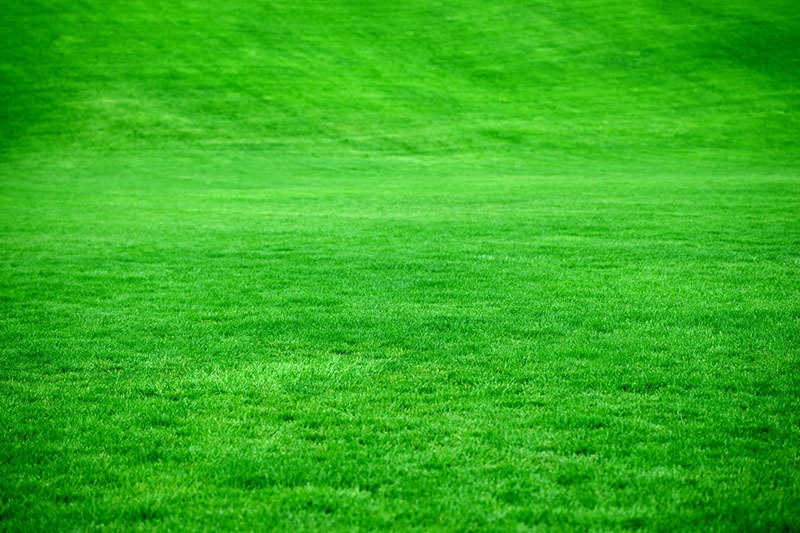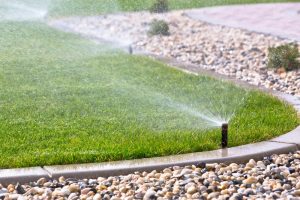
The grass doesn’t have to be greener on the other side. With these simple steps to greener grass, your lawn can be the envy of the neighborhood. Growing a green lawn is a labor of love and while it takes time, it’s worth the effort. We’ve compiled tried and true tips so you can put your energy in the right place.
Test the soil
Greener grass grows best when it’s growing in the “pH happy zone.” That’s when the pH level is between 6 and 7.2. If the soil is too acidic or too alkaline, the grass won’t thrive even if you are doing everything else right. The best way to find out your soil’s pH level is to collect one tablespoon-size sample a couple of inches under the sod in three different places in your yard and take those samples in for testing.
You can search online for “soil testing” nearby to find a place to bring or send your samples. If the soil’s pH is too high, you can treat the lawn with iron sulfate or sulfur. If it’s too low you will use pelletized limestone.
Choose the correct sod
When your goal is greener grass, you need to make sure your lawn will thrive in your climate. If don’t know what kind of grass you have, you could use an identification resource.
If you are installing a new law, you have the benefit of choosing the very best sod for your climate. The professionals at the Turfgrass Group can help you determine which of our cultivars will be best for your location.
You will need to water your lawn well after installation and keep it wet for a week. After a week, water it thoroughly every other day for two to three weeks following the steps below.

Watering properly is just one key to unlocking greener grass
Water properly
If you water frequently for short periods, the grassroots won’t have a chance to spread deeply into the ground. And that means these shallow roots can’t reach deep soil nutrients or deliver the water if you skip a watering.
For greener grass, the best way to water is to do so deeply enough to penetrate the soil 4 to 6 inches. Actual timing depends on weather conditions and your soil type. To test the watering depth, turn on your water for 30 minutes. Then plunge a spade into the soil and pry out a wedge to see how far the water has penetrated. If the water hasn’t reached at least 4 inches, keep watering longer. Once you know how long it takes to reach 4 to 6 inches, you can set a water timer for that length once a week. In hot, dry weather, you may have to water every two to three days.
Always water your grass in the morning. When there’s less sunlight and heat, the water will go through a natural evapotranspiration process. This is better than if it were to evaporate before the soil can absorb it. As the sun intensifies in the late morning, it will dry off the leaves, which helps prevent disease and moss.
Don’t mow a wet lawn
Never ever mow wet grass. Mowing wet grass leaves clumps of sodden clippings where they’ll smother the lawn beneath. Plus, it can tear the grass and damage the roots.
Tackle broadleaf weeds in mild weather
To be most effective you need to target weeds when they’re growing. That’s because the herbicide is absorbed through the leaves and then sent throughout the rest of the plant. When the weather is too cool, weeds aren’t growing. Therefore the herbicide won’t be absorbed, and the chemical isn’t as effective. If you apply the herbicide when it’s too hot, it will stress the grass. The product directions will give you the best temperature range. Take care to apply herbicides when rain isn’t in the forecast, as rain will wash away the treatment.
Kill crabgrass early
To prevent crabgrass, you’ll need pre-emergence treatment. They prevent crabgrass -and any other seed- from sprouting. Once crabgrass sprouts, it’s too late. That’s why the key is to apply the crabgrass preventer between the second and the third mowings of the spring. Because crabgrass sprouts a few weeks after the grass greens up, that’s the best way to catch this invasive grass.
Aerate in the fall
if you have heavy loam or clay soil, aerating in the fall will help promote greener grass. Just before you fertilize, aerate the lawn from both directions. This helps loosen the soil and allows the fertilizer to penetrate deep into the soil, resulting in healthier, greener grass. Check for heavy thatch build-up that needs to be removed before aerating your lawn.
Remember fall fertilizing
Before the lawn goes dormant for the winter, you should feed it well. Even after the growing season, grassroots are soaking up nutrients and storing energy for the next spring. However, it’s much more important to fertilize in the fall than in the spring. Choose a “slow-release” fertilizer. Rather than feeding the lawn all at once, this type allows the lawn to slowly feed over a longer period. These fertilizers cost a bit more but are well worth the added expense to keep your grass looking its best.
Reseed during cooler weather
Whether you’re filling in a patch at the beginning of the season or repairing the lawn after summer, your seed will have the best chances of sprouting in early spring or fall. Throwing down seed in the hot days of summer will just waste your time and money. Grass seed won’t survive if the weather is too hot and dry.
Get started on greener grass today
When you’re ready to install and maintain the lawn of your dreams, reach out to the pros at The Turfgrass Group. As the premier source for exclusive turfgrass cultivars, we remain on the cutting edge of turfgrass technology and engineering. And we can help you find a grower near you to install the best quality sod for your property. Get started on greener grass today!
